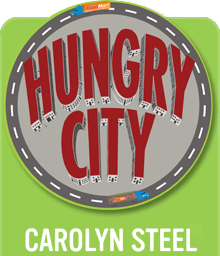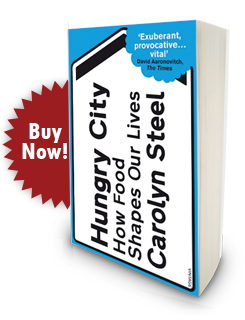Marylebone 2020
Tonight I took part in the Food Ethics Council World Food Day debate Fair Distribution in a Warmer World, held at the Royal Horticultural Halls in London.
My presentation consisted of a vision of what my London neighbourhood, Marylebone, might look like in 2020 if we lived in a fairer world that responded to climate change. Here is a transcription:
Marylebone 2020
I’ve lived in central London all my life, but I can’t believe how much it’s changed in the past fifteen years – in many ways it feels more like the London I knew in the 1960s when I was a child.
My street looks really different to the way it did then. The buildings are all made of brick, but since the Government passed its ‘Growing Spaces’ Bill in 2015, half of them have had growing-frames fitted to the front. People now spend hours out on their balconies, or on the flat roofs at the back, which used to be empty asphalt, but are now covered in raised beds for growing vegetables.
I know far more of my neighbours than I ever used to, partly because we meet at our local food shop, which used to be an estate agent. You never know quite what you’re going to find in there, but they have large seasonal charts on the walls with recipe ideas, so it doesn’t really matter.
Then of course there’s the big food market at Marylebone Station – it seems incredible there didn’t used to be one there! That was after the Government De-Beeching Initiative in 2012 kick-started its Rail Freight Programme. The market opened a couple of years ago, when the first phase of the Midlands-and-Chilterns Rail Lattice was completed. It’s turned my neighbourhood into a 24hour food hub, with far local more cafés and businesses than there used to be. The Lattice has really made a difference to motorway congestion too – I read recently that half of North London’s food now comes in by rail.
The other place I meet my neighbours is at our local Permaculture Centre in Regent’s Park, where I spend two evenings a week. It’s part of the London Canals Food Co-operative, and it’s run by my next-door neighbour, the first professional farmer ever to live in our street!
It’s great having animals living in the city again. Of course there was a lot of local opposition when they first came (and even more when they built the new Camden abattoir!) but people have got used to them now. We feed the pigs scraps from our local restaurant, and school kids love going to visit them.
Although I do grow some of my own, most of my seasonal fruit and veg. comes from the Thames Gateway. When we first set up Transition Westminster, a group of us formed a buyer’s consortium, and we have a stake in a network of Community Supported Farms there, who supply us through the year via the Thames Gateway Food Link.
Apparently almost a fifth of London’s seasonal veg now comes from the Thames Gateway – it’s amazing to think they were talking about building millions of houses on the floodplains there only 10 years ago!
The food comes in by rail to the Finchley Road Food Hub, on the site of what used to be an enormous Sainsbury’s, that closed after the Government introduced supermarket parking charges in 2010.
The deliveries come down my street twice a week by electric van, just like the old milk floats I remember from when I was a child. They carry milk too: the Hub also receives regular deliveries from the Buckinghamshire Dairy Co-operative. Funny how history seems to repeat itself…
I usually get my food deliveries left at our local grocery deposit box, where I can pick them up on my way back from work. I don’t eat much meat these days, but when I do, I still buy it from the Ginger Pig. That place has been going for over 25 years now – they were way ahead of their time: one of the first butchers in my area to source all their meat from their own organic farms.
For my tea, coffee and bananas, I go to my local Fair-Trade store, situated, ironically enough, in what used to be my local Tesco Metro. That closed down in 2012, after the Competition Commission finally got round to setting legal limits on grocery market share.
Fair Trade has really flourished since the International Agreement to Internalise Ethical Food Costs was passed in 2012. It was an amazing move that combined carbon costing with some of the other food costs – water depletion, social justice – that were never taken into account before.
In fact I think it was after the AIEFC was when the biggest changes came. That was when the Government finally scrapped its plans to build millions of new homes in the South East, and brought in its Regional Food Bill instead.
The Thames has been transformed by the Thames Gateway Food Initiative – it’s great to see so many boats on the river again, and Billingsgate once again being used as a live dock – not to mention all those yuppie flats in Docklands being converted into food processing units!
All the fruit and veg supplied to London from the Thames Gateway scores a perfect 10 on the Global Ethical Food Index, partly because of its low food miles, but also because of its zero-carbon production cycle, partly achieved through the barges bringing food waste back to the GLA’s anaerobic digesters in the Lee Valley – history repeating itself once again!
It’s fantastic that the old Olympics site was reconceived as a world-leading centre for eco-urban research. Apparently more people have come to visit it since the Games than when the they were being held!
My home life has changed a lot too. Now that my husband and I both work locally, we see much more of each other – we often come home for lunch. I think that started after the Mixed Communities Initiative, when the 2015 revision of PPS1 put food at the heart of urban planning. It’s amazing how my neighbourhood has changed as a result: sometimes it feels more like Barcelona than London – if it wasn’t for the weather, that is!
Twice a week, we eat food that my eight-year-old son has grown and cooked at school. He’s really changed since his classroom was made into a kitchen – he says that food studies is his favourite subject, and he wants to be a farmer when he grows up, which is great for us, since the pay is so good!
He often has his friends over for cook-overs. They love coming round to us, especially since we used our Government Kitchen Improvement Grant last year to put in our waste-fuelled ceramic hob and intelligent fridge. They love playing with the use-by indicator knobs!
London has always been a great place to live, but I really think it’s nicer since the Global Climate Change Initiative. Life has got simpler in many ways – slower, you could say – but it’s also far more rewarding – and varied.
The city feels more lively – more full of stuff. People have changed too. It’s amazing to think that Sir Terry Leahy used to run a global supermarket chain, and now he is an organic pig farmer. He’s apparently found his true vocation – and his Foundation for Rural Enterprise has really transformed the co-operative movements both here and abroad – talk about poacher turned game-keeper!
Note:
The place described above is what I call Sitopia (from the Greek sitos, food + topos, place). It’s a place made by food, which is nothing new – we already live in a world shaped by food. The difference with Sitopia is that we have recognised that fact, and have learned to use food as a tool to shape a better one.










